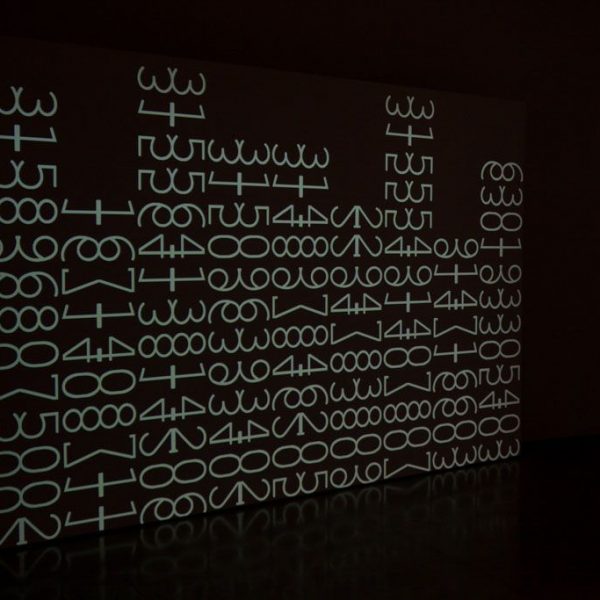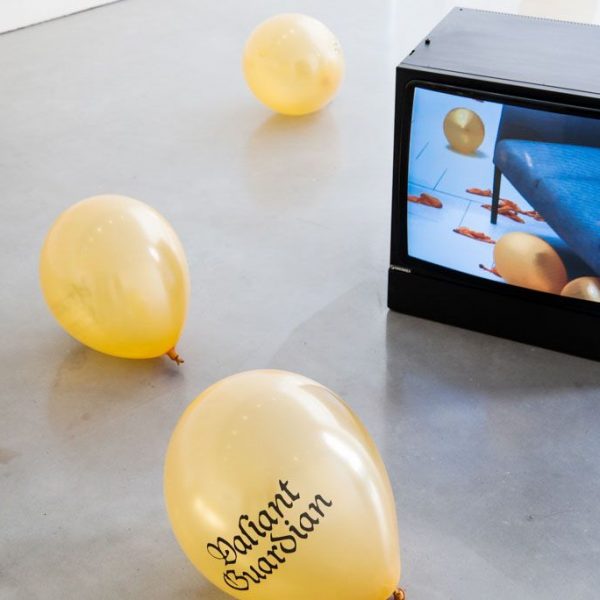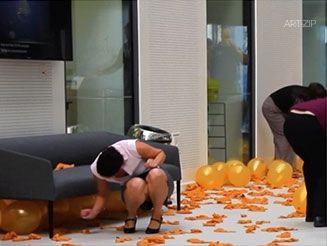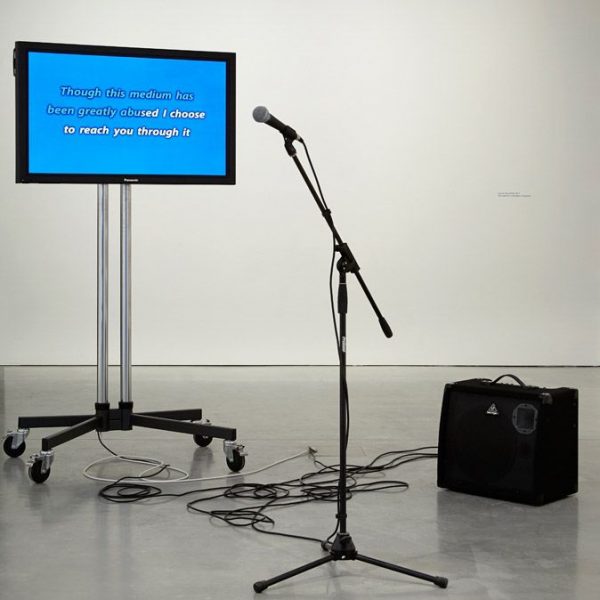
Interviewed and Text by 採訪及撰文x Nils Jean 尼爾斯•吉恩
Translated by 翻譯 x Michelle Yu 余小悅 Jay Chun-Chieh Lai 賴駿杰
Images Courtesy of 圖片提供 x Carroll/Fletcher Gallery 卡洛爾/弗萊徹畫廊
Photographed BY 攝影 x Syndi Huang 黃煥欣

Thomson & Craighead. Photographed by Syndi Huang.
Jon Thomson and Alison Craighead work across video, sound, sculpture, installation and online space, using technology as a means to reformulate fundamental human questions for contemporary times. Through sensitive appropriation of images, texts, and data from online sources, the artists produce generous, lyrical works that both exercise the dramatic conventions of cinema and examine the changing socio-political structures of the Information Age. In their works, time is treated with a sculptor’s mentality, as a pliable quantity that can be moulded and remodelled.
The duo create generative visual and musical systems that employ chance operations as a means to cut loose from the confines of traditional narrative, re-contextualising the familiar to allow for new readings of known structures and situations. These works mimic the fragmented frameworks of global communication systems while also exploring the implications of these systems on human relations to time and space. For Thomson & Craighead, the spectre of humanity is always present in the machine, even as a disappearance. The pair expose the concealed politics of cyber-interaction, giving tactile form to the multitude of anonymous disembodied voices inhabiting the internet. The encounter with these ghosts is what drives the poetics of the artists’ practice: the viewer seeing themselves within the work, their experiences mirrored, reframed, and made strange.
Thomson & Craighead apply a diverse range of conceptual tactics, evoking 1960s systems art, 1970s structuralist film-making, the intellectual rigour of early Minimalism, and the compositional constraints of the influential Oulipo literature group. This intentional shifting of form and approach is vital to Thomson & Craighead’s practice; art-making as a scavenger hunt for meaning in a landscape of constant change, or as Italo Calvino said, “A classic is a book that has never finished saying what it has to say.”
Presented an engaging and successful show at Carroll/Fletcher, the duo sat down with us to talk about some of the intentions behind Party Booby Trap and what it means to work with streams of data in contemporary art.
喬恩·湯姆森和艾莉森·雷格黑德(Jon Thomson and Alison Craighead)的創作跨越影像﹑聲音﹑雕塑﹑裝置和線上空間,他們擅於利用技術,使之作為一種重新詮釋當今人類基本問題的一種手段。通過將在線的圖像﹑文字﹑數據和其他資源進行敏銳的挪用,藝術家創造出豐厚的抒情作品,既運用了電影語言的戲劇性,同時又檢視了信息時代社會政治結構的變化。在他們的作品中,時間成了雕塑家手上的原材料,不斷被雕琢,被鑄造,被重塑。
這對藝術搭檔創建了能自我生成的視覺及音樂系統,利用隨機的操作方式擺脫傳統敘事的局限,將熟悉之事置入新的語境當中,讓觀者對已知結構及情境產生全新的解讀。他們的作品模擬了全球通信系統中支離破碎的架構,探索著這些系統對人類與時間、與空間的關係所帶來的影響。對湯姆森和克雷格黑德(Thomson & Craighead)來說,機器總是帶有人性的部分,儘管不是直接的顯現。Thomson & Craighead揭示了網絡交流中潛藏的政治,那些互聯網上的匿名聲音變得可見。與這些“幽靈”的不期而遇驅動著藝術家的詩意實踐,而觀眾則在作品裡看見自己,自身的經歷也被映照,被重塑,並變得陌生。
湯姆森和克雷格黑德採用多種觀念交織的手法,讓人想起1960年代的系統藝術,1970年代的結構主義電影,早期極簡主義的嚴謹,還有烏力波潛在文學工廠的組合限制理念。這種刻意轉換形式與方法對他們的實踐尤為重要。他們就像清道夫一樣在不停變幻的景觀裡捕捉意義,或者引用伊塔羅·卡爾維諾的話來說:“經典如冊,娓娓道來,取之不盡。”
在Carroll/Fletcher畫廊成功舉辦了第二次個展《派對詭雷(Party Booby Trap)》,湯姆森與克雷格黑德隨坐在旁,與我們暢談展覽背後的想法以及當代藝術裡使用數據流創作的意義。

Jon Thomson & Alison Craighead. Photographed by Syndi Huang.
Interview with Thomson & Craighead 專訪湯姆森與克雷格黑德
ART.ZIP: The show presents a lot of new works, have they been conceived especially for Party Booby Trap?
JT: A lot of the works were made especially for the show, because we’ve known that we’d be doing this exhibition since last autumn. Although one of the works, Temporary Index, is part of an extended research based project, which is called Nuclear Culture. Dr Ele Carpenter, at Goldsmiths, is overseeing a large project that looks at the ways in which our legacy nuclear culture is embedded within the art world, but also within sociological frameworks. It is a vastly interdisciplinary project and we are one small part of this.
AC: I think that the really broad themes of the show are about dealing with time. The nuclear counters are talking about really massive timescales and then maybe the Apocalypse perfume is talking about the end of time, the end of the world. We are trying to look at the hubris of thinking about time in different ways. There are small sections of time and then big pictures of time.
JT: Stutterer, which we have shown three times, takes ourselves into a huge stream of text, which is the human genome. It represents an individual person, that’s 3.2 billion letters. Although it is the representation of one person, to actually see the nuclear time describing the whole of the genome it suddenly becomes an unimaginably long data set. We use that as a score and then to trigger videos and create what we call poetry machine. It reflects upon the 13 years it took for the human genome to be sequenced for the first time. We end up creating a form of monument, but also an unimaginable representation of a self.
ART.ZIP: 這次展覽呈現了不少新作品,它們是特別為《派對詭雷》所創作的嗎?
JT: 許多作品是特別為這次展覽所創作的,從去年秋天開始我們就知道要辦這次展覽。但其中一件作品——《暫時的索引(Temporary Index)》——是《原子核文化(Nuclear Culture)》研究課題的一部分。 這個課題是金匠學院的艾爾·卡蓬特(Dr Ele Carpenter)指導的一個大型研究項目,這個項目探索的是原子核文化如何滲入藝術與社會學。它是一個龐大的跨學科研究計劃,而我們只是參與了其中一小部份的研究。
AC: 我認為這次展覽更寬廣的主題是關於時間的。有關原子核的作品談論的是宏大的時間緯度,而香水作品《末世(Apocalypse)》則是討論時間的盡頭——世界末日。我們試著用不同的方式觀測時間,觀看一小段時間裡的以及更龐大時間框架裡的“時間”。
JT: 作品《結巴(Stutterer)》已經被展示過三次了,它把我們帶進了一個無比龐大的文本裡,也就是人類基因組。這個有著32億個字母的人類基因組代表了一個獨立的人。雖然只代表了一個人,但把這個基因組用時間的方式來呈現的話就變成了一個無法想像其長度的數列。我們利用這個數列作為樂譜,來觸發影像的播放,兩者的結合成為了我們所創造的“詩歌機器”。《結巴》思索了首次成功排列人類基因組所花費的時間: 十三年。《結巴》就像一座紀念碑,紀念著時間,但同時它也是對一個人的描繪,只是這種描繪難以想像。
ART.ZIP: It is really interesting to see how the works displayed are like a set of pointers displayed in the gallery space, they are evocative without telling the viewer what to think, but rather what to consider. Are you thinking in term of accessibility when you’re in the process of making the work?
AC: Common Era is a series of crayon drawings that have a collection of statements or predictions of when the world will end. In a way, we see it very much like a documentary. We imagine documentary to be a film, but actually we’re showing 16 predictions for the end of the world and by just pitting them against one another you start to see the dates that have passed and the ones that are very into the future. It’s an interesting gaze.
JT: They start to act on each other. You can see there are false statements; you can see that there are statements that we can’t really contemplate. In acting on each other we’re hoping that it opens up the form, the idea of making a prediction in the first place, because it seems to me to be a hubristic tendency when we all live in a universe we have no control over. So making a prediction of a world’s end is an act trying to take control. Seeing them operating in that way refers to religion and refers to science.
When you ask the question about the space that the work creates, it’s very important to us, critically, that we make work that’s not too didactic, not making something that proselytising. Rather, we’re trying to create spaces that might allow for critical engagement, but we don’t see ourselves outside of that. We see ourselves, in an anthropological sense, participant observers. I think Untitled (balloon work) is very much like that, because we’re trying to make quite spectral connections with warfare and how it impedes on our psyche collectively. How we collectively live in a constant state of denial.
AC: We all know we’re at war at the moment, but it’s very easy to tune out of it. We’re thinking that somehow watching those balloons and the noise of them bursting sounds so like anti-aircraft trials.
JT: It is the act of those women popping balloons after a corporate balloon drop, in the video work, combined with the balloons in the gallery space inscribed with the names of the military actions: ‘Dessert Storm’, ‘Urgent Fury’. The names are so romantic. They’re heroic, they’re propaganda, they’re idealistic. The way in which all of that horror is mediated to us is interesting and how we ritualise things.
AC: We’re trying to look at the language of war.
JT: But in a way that’s very open-ended.
ART.ZIP: 這次展覽的作品陳列方式很有趣,像一組組標示一樣呈現在畫廊的各處。作品之所以能引起共鳴並不是告訴觀者思考什麼,而是看作什麼。你們在創作的時候會考慮作品的可讀性嗎?
AC:《公元(Common Era)》是蠟筆畫作品,上面集合了一系列關於世界末日的宣言或預言。在某種程度上來說,它就像是紀錄片一樣,紀錄片應該是電影一樣的,但是我們呈現的只是16個世界末日的預言,把它們一個個並列排放,你會發現它們是互相對立的,有些預言提及的末日時間已經過去,有些還在未來。我覺得看著這些對比和矛盾很有意思呢。
JT:它們之間相互起著作用。因為你可以看到那些錯誤的預言,你可以看到那些我們無法明白的宣言。我們希望通過這些預言展開討論,看看我們是那麼的狂妄,活在一個根本無法控制的宇宙裡。無論是宗教還是科學作出預言,這都是試圖奪得控制權的一個行為。
關於你問到的創作空間,我們認為非常重要。我們不會把作品做得很說教式的,也不會是偏頗的。相反地,我們更願意營造空間讓觀者進行批判參與,但是我們也不是置身事外的。我們更像是一個參與型的觀察者,從人類學的角度來看待周圍的一切。我想氣球作品《無題(Untitled, balloon work)》就是那樣的,我們試圖讓這個作品與戰爭產生一種聯繫,看看戰爭怎麼影響集體心理的,我們怎麼在一個消極否定的狀態下共處。
AC: 我們都知道世界上還有戰爭的發生,但我們總是很容易把它屏蔽掉。那些氣球的爆破以及它們發出的聲音就像是放空演練。
JT: 這個作品是影像與現場相結合的一個作品。視頻裡的女士們是在公司舉辦活動後將氣球刺破,而畫廊現場的氣球則印有軍事行動的名稱:“沙漠風暴”,“狂暴怒火”等等,那些名字是那麼的浪漫。它們是英雄主義式的,它們是煽動式的,它們是理想主義的。那些爆破帶來的恐懼總是突然發生,而我們總能微妙地把這種恐懼轉化為見慣不怪的事情。正如人們對待戰爭的態度。
AC: 我們試圖觀察這些關於戰爭的語言。
JT: 從某種程度上來說,我覺得那是開放式的,我們在觀察。
ART.ZIP: The works presented for Party Booby Trap seem to have a sense of wit in them. Humour has always been present in your practice; do you think that in this instance, humour plays an even more important role?
AC: I think there’s satire in many of the works and there is, I hope, humour because we don’t want our gaze to be cruel. We want it to say: ‘we are part of this’. The title of the exhibition, Party Booby Trap, gives a clue to the uncomfortableness. The title is a palindrome, it can be read both ways and there’s an uncomfortableness using the term booby.
JT: It gets a lot of hits online, I can tell you that.
AC: We put an image of the show on Flickr with the name of the show, using the word booby we had 12 000 hits in 24hrs without us doing anything.
JT: That’s the Internet, but I think humour is critically important to us and also satire. Underlying a lot of the works that we are making is that idea of the architecture of language, space and time and the way we perceive the world. We often interrogate those architectures and structures. The Internet is a very good example of how we understand that information is distorted by templates and structures.
AC: Facebook, Google, the browser…
JT: But that feeds back into the physical world as well, physics, gravity and language is a good place to play with those. Also with humour, if people find something a little bit funny their guard comes down a bit and perhaps the work can communicate a little bit more directly. It can be a strategic device.
ART.ZIP: 展覽《 派對詭雷》中的作品都充滿著機智詼諧。幽默經常出現在你們的藝術實踐裡,你們覺得在這個作品當中,幽默是不是更重要?
AC: 我覺得許多作品都帶有諷刺意味的,但同時也有幽默,因為我希望我們的注視變得不那麼殘忍。我們想說的是,“我們也身在其中”。展覽的標題《派對詭雷》暗指了這種不安。題目是回文的形式, 順著讀或逆著讀都是成立的,而且用“笨蛋/乳房(booby)”這個字眼會讓人有種不舒服的感覺。
JT: 但網上點擊率很高啊!
AC: 我們只是把一張展覽照片和標題發佈到Flickr上,“booby”這個關鍵字讓我們的點擊率在24小時內達到了12000多次。
JT:這就是互聯網,但是我想幽默對我們來說特別重要,諷刺也是。我們許多作品的想法都是基於語言、空間、時間還有世界觀的建構。我們經常審視那些建構和結構。互聯網是一個很好的例子來表現如何利用模塊和結構來扭曲信息的。
AC: 臉書、谷歌、瀏覽器等……(都是“幫兇”)。
JT: 但這些虛擬世界的反饋在實體世界也同樣說得通,你看,物理性、吸引力、語言這些都是可以把玩的。同樣地,如果人們發現有趣的事物,他們就會放下戒備心,也許通過幽默可以讓作品與觀者的交流更直接一些。幽默也許可以被視為一種策略吧。
ART.ZIP: You’ve always worked with streams of data, how has the evolution in the ways in which information is circulated shaped your practice?
AC: I guess, The First Person, comes very much about a change in focus through status updates, about media becoming very narcissistic and very person centred. We have a video of a house, which is constantly in a process of burning down but never burns down. It cut through inter-titles that we took from a website called The Experience Project where people put a limited number of characters looking for people who feel the same ‘I hate Mondays’, ‘I love soldiers’ and they’re looking for like-minded people to create those communities with that particular interest. It becomes this kind of hypnotic work.
JT: We’ve described it as a cinematic plateau stage, because you always arrive in the middle and it never ends. I think using randomness in that work can be really meaningful or it can be quite jarring or meaningless. As viewers, we are left in that almost liminal space.
AC: I think we see a change towards a worship of the self with social media and the work is looking at those kinds of first person statements.
JT: The Internet is a good example of how things have changed. We started making work when the web began to attract attention. In the early 90s it was a very different space, it was very idealistic. Anybody could make a web page, everyone was writing their own utopia and how it would change the world, capitalism will fall, and now we have a shopping mall as Internet.
ART.ZIP: 你們經常運用數據流來進行創作,信息傳播的變革是如何影響你們的實踐的?
AC: 我們的影像作品《第一人稱(The First Person)》特別提及了這種個人狀態更新的變化,媒介變得自戀和自我為中心。視頻裡的房子處於一個正在被燃燒、但卻又永遠不會被燒毀殆盡的狀態。影片穿插著一些過場字幕,這些字幕從一個叫《經驗項目(The Experience Project )》的網站上提取的,在這個網站上,人們可以在限定字數內發佈一句話,例如“我恨週一”,“我愛士兵”等等,然後志同道合的人就可以針對這句特定的話進行留言進而產生進一步的交流。我們就是結合了這個碎片影像和文字,繼而創作了這個具有催眠屬性的作品。
JT: 我們把它描述為電影式的高原期,因為你永遠只能看到中間部分,沒有結尾。我想在作品中運用隨機性會很有意義,或者也有可能讓人不安或者覺得毫無意義。作為觀者,我們被留在了閾限的空間裡。
AC: 我們見證著社交媒體中自我崇拜的轉變。這個作品就是觀看這種”第一人稱”的發生。
JT: 互聯網是展現事物如何變遷的一個好例子。當互聯網開始受到關注的時候我們便開始創作。在90年代早期,互聯網是一個特別不一樣的空間,它是理想主義的。任何人都可以創建網頁,任何人都可以書寫他們自己的烏托邦,如何改變世界,如何消滅資本主義等等,但現在,互聯網就是一個巨大的“購物商場”。
ART.ZIP: Your work has recently been exhibited in Electronic Superhighway, how do you approach this type of conversation?
AC: I think it was really exciting to be exhibited in that exhibition.
JT: We were quite surprised to be on the ground floor.
AC: We thought we’d be with the slightly more senior people, on the top floor, so we were actually happy to be included among the young artists.
JT: A show like Electronic Superhighway is quite hard to talk about because it’s a sort of landmark survey exhibition and the catalogue is quite interesting I think. The exhibition is an explosion of stuff and it’s quite instructive actually.
AC: I thought it was quite exciting actually, a little bit like the Royal Academy’s Summer Exhibition, it was like a salon hang and I’ve never seen before and they’ve done a brilliant job. If you ever said to me we’d do a salon hang of media works, I would say that couldn’t work.
JT: The work they’ve included is a good piece from my point of view, because it has a kind of autonomy and can operate in and of itself. What sits around the work becomes its own context.
AC: I’m very pleased, we were talking with Emily [Butler] one of the curators, we had people singing karaoke everyday in front of our work More Songs of Innocence and of Experience. It’s lovely to Google it and see online people performing your work for you.
JT: It was a fascinating show, quite interesting at the time as well, because there was also Big Bang Data [1]at Somerset House, which is quite an interesting comparison. It wasn’t an art show in the same sense, but still interesting to see these different angles.
ART.ZIP: 你們的作品在《電子高速公路(Electronic Superhighway)》中亦有展示,你們是怎麼展開討論的呢?
AC: 能在這個展覽上展示我們的作品讓我們十分興奮。
JT: 而且作品在一樓展廳展示讓我們感到十分驚訝。
AC: 我們以為我們會與稍微年長一點的藝術家一併展示在頂層的展廳。我們很開心能和年輕藝術家們一起展示。
JT: 像《電子高速公路》這樣的展覽很難去討論,因為它是一個標竿式的調查展覽,畫冊也非常有意思。展覽本身就很包括了很多不同形式的作品,其實挺具指引性的。
AC: 我覺得挺讓人激動的,有點像皇家藝術學會的夏季展,有點像沙龍展,很多作品我之前都沒看見過,作品都很棒。在這個展覽之前,如果有人跟我說以沙龍展的形式來展示新媒體作品,我肯定會說不可能。
JT: 我個人覺得展覽很不錯,每一件作品都有自治性,作品可以自己發聲的同時,其他與之一起展出的作品則又為原來的作品創造了新的語境。
AC: 展覽其中一位策展人艾米麗·巴特勒(Emily Butler)告訴我們,每天都有觀眾在我們的作品《更多純真體驗的歌(More Songs of Innocence and of Experience)》前唱卡拉OK,我真的很開心。通過Google谷歌可以搜索並看到觀眾為我們表演感覺真的很好。
JT: 這是個很棒的展覽,有趣的是,薩默塞特宮(Somerset House)差不多在同一時間也舉辦了關於互聯網數據的展覽《數據大爆炸(Big Bang Data)》,這兩個展覽的對比特別有意思。《數據大爆炸》不是藝術展覽,但是從不同角度觀看這些日常的網絡數據是很有意思的。
ART.ZIP: You’re also educators, what is the most challenging when you work with young practitioners?
AC: Being in the studio with young artists is really exciting because they grew up with the Internet and with computers. It’s just a very different way and a very natural way, it isn’t a political decision to work with video rather than paint, it’s just, well, these are the materials we have to hand. It’s really exciting that they don’t see boundaries in the same way as was when I was 19. I had to fight to get into a computer department and the fine art tutors thought I was crazy. Now of course that wouldn’t happen in the same way.
ART.ZIP: 你們兩位都是教育工作者,你們覺得和年輕藝術家一起工作最大的挑戰是什麼?
AC: 與年輕藝術家一起在工作室是很棒的,因為互聯網和電腦伴隨著他們成長,所以他們的實踐方式和我們不一樣,他們也是很自然地會選擇視頻而不是繪畫,並不是什麼政治抉擇,只是這些素材都是現成的,都是他們隨手可及的。讓我感到高興的是他們不會像我19歲時那樣有著這樣那樣的局限性。當時的我要很艱難才能爭取進入電腦系,我的藝術系導師當時覺得我肯定是瘋了。當然,現在同樣的情況不會再發生了。
[1] Thomson and Craighead were exhibiting London Wall (2015) and Horizon (2015) at Big Bang Data.
More about Thomson & Craighead
































